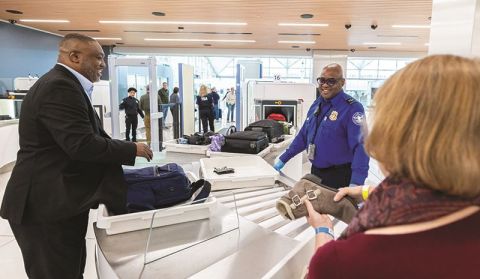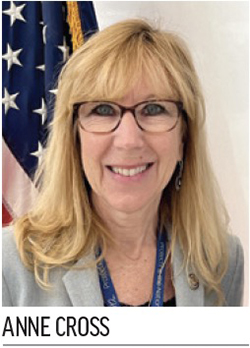Denver Int’l Completes State-of-the-Art West Security Checkpoint

After the events of Sept. 11, 2001, Denver International Airport (DEN) had to quickly establish a security checkpoint, and opted to do so on Level 5. The area had previously served as a “meet and greet” open space focused on retail, and it had to be converted to provide a space for the newly created TSA and its operations.
In the last two decades, passenger volume has nearly doubled at DEN, and security technology has changed considerably. As part of the airport’s Great Hall Program, a $2.1 billion capital improvement project, all checkpoints are moving up a level—both physically and technologically.
“The impetus of the Great Hall Program has always been to enhance safety and security by moving the security checkpoints from Level 5 to Level 6 while also increasing capacity,” Chief Executive Officer Phil Washington said in a February press release. “This new checkpoint, which is opening on schedule and under budget, is equipped with 17 screening lanes. These have advanced technology creating a more efficient process and an overall better experience for our passengers.”
Naturally, accommodating more passengers means increased security needs; so managing wait times and minimizing customer frustration were emphasized as plans for the Great Hall took shape.
|
facts&figures Project: New West Security Checkpoint Location: Denver Int’l Airport Airport Owner: City of Denver, CO Checkpoint Size: 17 automated screening lanes Capacity: 180-200 passengers/lane/hour Approx. Cost: $240 million, fully funded by airport Architect & Planning Consultant: Hensel Phelps Automatic Screening Lanes: Scarabee Security Group, now called Webb Daifuku Computed Tomography Scanners: Smiths Detection Wayfinding Displays: Nanolumens Stanchions & Physical Barriers: Lavi Industries Checkpoint Open: Feb. 2024 Key Benefits: Enhanced security; accommodating increased passenger volume; operational efficiencies; improved checkpoint experience for travelers |
According to TSA, the new checkpoint is capable of screening 180 to 200 passengers per lane per hour. That’s about 25% more than the previously established South Checkpoint, which can manage 130 to 150 people per lane per hour. The new West checkpoint is open from 4:30 a.m. to 7:30 p.m.; the South Checkpoint only closes briefly after 1 a.m.
100 Million…and Beyond
The airport opened to great fanfare in 1995, showcasing a majestic multi-peaked roof designed by Fentress Bradburn Architects. The Jeppesen Terminal was ahead of its time, jam-packed with the latest technology and passenger processing systems. Initially, the public at large wasn’t sure how it felt about the location 24 miles outside of the city limits, but DEN was clearly more advanced and modern than the downtown airport it replaced—Stapleton International, built in 1929.
Originally, DEN was designed and built to accommodate 50 million passengers, which was considered a stretch goal at the time. To understand the magnitude of DEN’s growth since, compare the numbers: 32.3 million passengers passed through DEN in 1996, and in 2023, DEN served almost 78 million. Airport executives anticipate that number to reach 100 million sooner than later.
“Our growth has continued to build,” affirms Michael Sheehan, DEN’s senior vice president of special projects. “Ultimately, in 2021 we thought the timeline to get to 100 million would be about 10 years or so. We’re on a fast track; now we’re estimating we’ll hit that number by 2027/2028.”
Per the goals of the Great Hall project, the first two of three phases are focused on building new ticketing and check-in spaces alongside the new West Checkpoint on Level 6. The new checkpoint itself branches off into three parts:
- West Security 1: standard screening, which makes up the majority of DEN passenger flow
- West Security 2: military, accessibility and functional needs, premium/premier access, and DEN Reserve (an online checkpoint reservation system run by the airport)
- West Security 3: TSA PreCheck passengers and CLEAR customers with TSA PreCheck
In addition to the new West Checkpoint, TSA will continue screening at the South Security Checkpoint and the A-Bridge Checkpoint.
All New Equipment
The airport worked closely with TSA to plan and design the new West Checkpoint, which has 17 automated screening lanes, computed tomography (CT) units with the most current X-ray screening technology, and nine Enhanced Advanced Imaging Technology (eAIT) body scanners. All in, the project cost about $240 million and was completely self-funded by the airport.
Scarabee Security Group, now called Webb Daifuku, provided the automated passenger screening lanes, which are paired with Smiths Detection HI-SCAN 6040 CTiX baggage scanners. These scanners use CT to produce high-resolution 3D images, and advanced algorithms to improve detection results, says Smiths Detection Aviation Sales Manager Joe Kennedy.
They also notably improve the checkpoint experience for travelers.
 “With CT X-ray imaging, passengers no longer need to divest large electronics from their bags,” Kennedy explains. “This technology can reduce the instances of manual bag searches, which can greatly expedite screening time.”
“With CT X-ray imaging, passengers no longer need to divest large electronics from their bags,” Kennedy explains. “This technology can reduce the instances of manual bag searches, which can greatly expedite screening time.”
Sheehan is proud of DEN’s remote passenger screening capabilities. TSA officers in rooms directly below the DEN checkpoint monitor images on computer displays to keep lines of travelers moving toward their gates. Each screener is responsible for watching one and one-half lanes.
In addition, passengers can opt into facial recognition identification to make processing even faster. And with the CT units in place, even passengers who haven’t registered for TSA PreCheck can leave large electronics in their carry-on bags.
“We want to be at the bleeding edge of innovation while improving customer service,” says Sheehan. “We have a robust training program in place; we’re working very hard with our federal partners to make sure they’re trained.”
Partnering with TSA
The West Checkpoint opened this February, but Sheehan and his team started meeting with TSA about the project at least three years ago.
 “We also interfaced with Hensel Phelps for the design,” says Anne Cross, TSA deputy federal security director for Colorado. “They made sure the TSA officers had enough space to complete prescreening and post screening, plus the presence of local law enforcement.”
“We also interfaced with Hensel Phelps for the design,” says Anne Cross, TSA deputy federal security director for Colorado. “They made sure the TSA officers had enough space to complete prescreening and post screening, plus the presence of local law enforcement.”
In addition to making sure there would be enough room for passengers and personnel, TSA had other specific requirements. For instance, supervisor podiums needed to be tall enough to provide views of the entire checkpoint area; and private screening rooms needed to be close to the checkpoint lanes. In addition, TSA encouraged the airport to proactively prepare for future K-9 certification, which meant leaving enough viewing space for dog handlers to operate and move through the area.
Cross and her TSA colleagues have high praise for the airport team and vendors involved in the project. The local TSA team worked hand-in-glove with all parties to keep the project on time and on budget, she notes.
 “We were meeting two to three times a week, three to four months out from the opening,” says Bryce Jensen, TSA deputy assistant federal security director for screening at DEN. “Anytime anything came up, we went over the smallest details to make sure everything was on track.”
“We were meeting two to three times a week, three to four months out from the opening,” says Bryce Jensen, TSA deputy assistant federal security director for screening at DEN. “Anytime anything came up, we went over the smallest details to make sure everything was on track.”
It helped that TSA personnel at DEN have good relationships with their counterparts at other airports, adds Marcy Donelly, acting federal security director for Colorado. For instance, TSA officers at George Bush Intercontinental Airport in Houston (HOU) and Portland International Airport (PDX) in Oregon had experience working with the checkpoint equipment DEN was installing, so they shared their knowledge and provided real-time demonstrations.
 Like Cross and Jensen, Donelly is pleased with the new checkpoint at DEN. “We’re using state-of-the art technology, and the space is excellent and allows the proper environment for our officers to work,” she says. “Passengers first, safety always.”
Like Cross and Jensen, Donelly is pleased with the new checkpoint at DEN. “We’re using state-of-the art technology, and the space is excellent and allows the proper environment for our officers to work,” she says. “Passengers first, safety always.”
Helping Passengers Find the Way
Queue management systems from Lavi Industries help guide passengers into the new West Checkpoint. The company’s Beltrac belted stanchions stand on steel ferritic magnetic plates that are affixed to the floor with removable 3M adhesive. The plates are designed to be easier to move than those drilled into the floor, an important feature if DEN wants to reconfigure its queuing patterns.
In addition, the double-belt stanchions are detectable for sight-impaired passengers using canes, making them compliant with Americans With Disabilities Act guidelines.
Lavi worked closely with the local fire marshal to ensure emergency exits were accessible. “The barrier gates are magnetic and open with 7 pounds of force,” explains Lavi Sales Manager Paul Herren. “All of our stanchions are made for the belts to break free if people need to run through, versus fixed stanchions that could create a barrier.”

The sleek new checkpoint is designed to accommodate up to 200 passengers per lane per hour.
 Mindy Crane, director of Stakeholder Communications at DEN, notes that wayfinding and customer service have been top priorities throughout the project. To augment its digital signage, the airport uses volunteer ambassadors to help guide guests throughout the terminal. During spring break and other significant holiday periods, DEN ramps up both volunteer and paid staffing.
Mindy Crane, director of Stakeholder Communications at DEN, notes that wayfinding and customer service have been top priorities throughout the project. To augment its digital signage, the airport uses volunteer ambassadors to help guide guests throughout the terminal. During spring break and other significant holiday periods, DEN ramps up both volunteer and paid staffing.
“We find opportunities to make sure we’re communicating clearly with passengers,” says Crane. “We’re starting to see that passengers are becoming very aware of the West Checkpoint and want to experience it themselves.”

Sheehan, who has experienced the checkpoint as a ticketed passenger, is complimentary about the new screening process. “Passengers can really move very quickly through it even on peak days,” he reports.
But Sheehan hasn’t completely closed the book on the project. “It’s a brand-new checkpoint, and I’m confident that as our federal partners get past the learning curve, it will speed up the process and improve wait times.”
TSA’s Jensen also sees the West Checkpoint as a work in progress. “This is a massive project that is new for the officers, too, and we’ll continue having team dialogue moving forward,” he says.
With the remaining elements of its Great Hall Program scheduled to be finished by the end of 2027, DEN is preparing for even more growth.
“We have to build for 125 million passengers, not just 100,” says Sheehan.
FREE Whitepaper
PAVIX: Proven Winner for All Airport Concrete Infrastructure
International Chem-Crete Corporation (ICC) manufactures and sells PAVIX, a unique line of crystalline waterproofing products that penetrate into the surface of cured concrete to fill and seal pores and capillary voids, creating a long lasting protective zone within the concrete substrate.
Once concrete is treated, water is prevented from penetrating through this protective zone and causing associated damage, such as freeze-thaw cracking, reinforcing steel corrosion, chloride ion penetration, and ASR related cracking.
This white paper discusses how the PAVIX CCC100 technology works and its applications.








